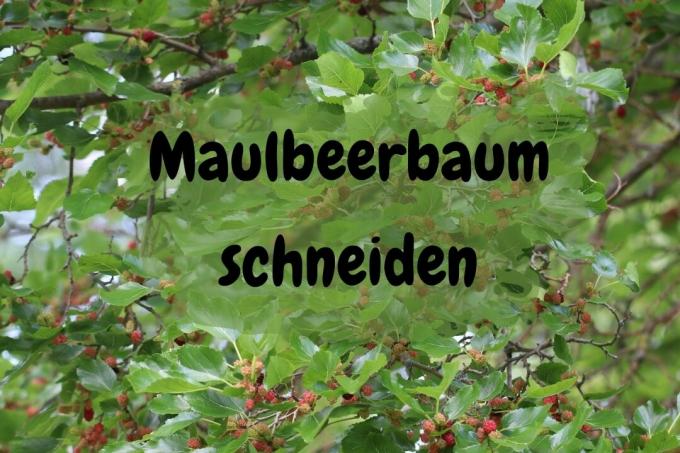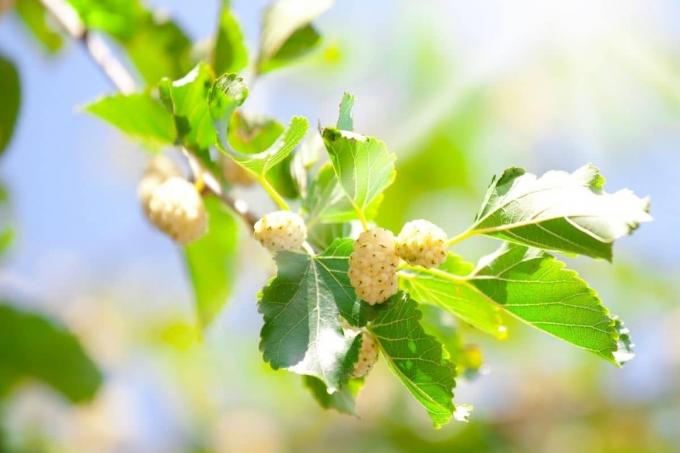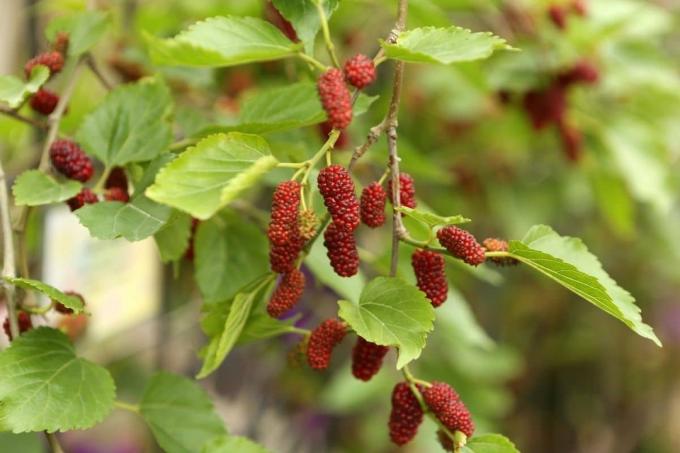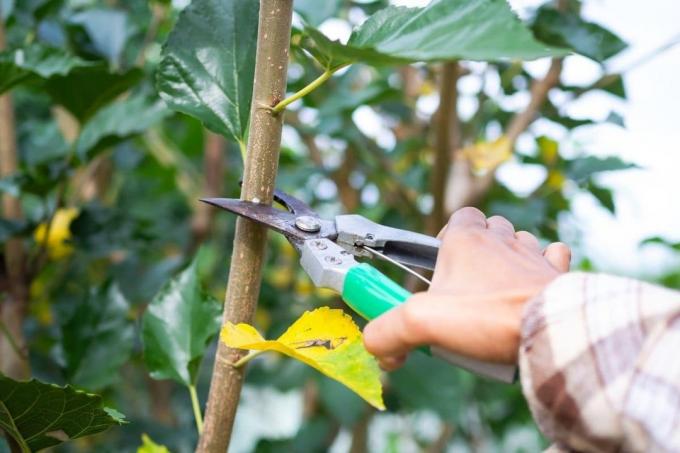
table of contents
- Cutting back - useful or not?
- Maintenance and topiary cut
- Education to the tree
- Mulberry hedge
- Trellis shape
- frequently asked Questions
Unlike apple or other fruit trees, you don't have to cut the mulberry tree (Morus) for a rich harvest. However, pruning can make sense, as the exotic wood grows very quickly with an average increase of 40 centimeters per year.
In a nutshell
- It is not necessary to prune the mulberry tree
- forms fruit on old and new wood
- very rapid growth, possible up to 70 centimeters per year
- Keeping the mulberry tree small is possible, but difficult
- suitable as a hedge plant
Cutting back - useful or not?
First of all, you can cut the mulberry tree, but you don't have to. Mulberry trees, regardless of their type, are considered to be vigorous and at the same time very easy to prune. Nevertheless, you should plant such a tree in a suitable location with enough space in width, as it can be kept small with secateurs difficult: you would have to shorten the specimen in question twice a year, once in early spring and once after the harvest in autumn. This is a lot of work and often ensures that the tree really accelerates its growth. The fruit development can also suffer from the heavy pruning, so that you have many branches and leaves, but few fruit.
White Mulberry (Morus alba)
- Height: up to eight meters
- Width: up to four meters
- Growth rate: an average of 40 centimeters per year

Black Mulberry (Morus nigra)
- Height: up to 12 meters
- Width: up to four meters
- Growth rate: grows a little slower than Morus alba

Red Mulberry (Morus rubra)
- Height: up to five meters
- Width: up to four meters
- Growth rate: particularly vigorous, up to 70 centimeters per year

All mulberry trees naturally have a sparse habit, grow as a large shrub or small tree and develop a rather rounded crown. An education to a certain growth form, such as the roof shape, is possible through targeted cutting measures.
Tip: With such a vigorous wood, we generally advise against keeping it in a bucket, unless you opt for the dwarf mulberry (Morus accidosa 'Mulle').
Maintenance and topiary cut
If you want or have to cut the mulberry tree because the space is quite limited and you want to limit the growth of the tree, it is best to proceed as follows:
- first cut in early spring before budding
- Cut out dead and dead wood
- Cut out intersecting branches
- Cut out inward-growing shoots
- Thin out the crown a little if necessary
- Shorten shoots that are too long to one eye pointing outwards

The gardener understands the "eye" to be the small knots on each shoot, from which new shoots can grow. Since outward-directed growth is desired (otherwise the crown will be too dense and the fruits will not ripen as well), the "knot" for new shoots should be on the outside when pruning. When cutting, make sure that the crown retains a natural, rounded shape.
Tip: A second pruning takes place after the harvest in early autumn, which is what is known as a “summer pruning” - even if it is done in September. This is supposed to slow down the growth of the tree.
Education to the tree
Mulberries usually grow as large, multi-stemmed shrubs and rarely take on the shape of a tree. To the tree, you need to raise the mulberry, which is done by appropriate pruning measures in youth:
- Plant the mulberry
- Select a strong leading shoot with many side shoots as the trunk
- Form crown from side shoots
- Shorten the side shoots, bring them into a rounded shape
- remove all excess shoots
- Pay attention to the desired trunk height
- If necessary, shorten the leading shoot, must not be higher than the crown
Always cut back the excess shoots completely, it is not necessary to close the cut wounds. The milky juice that escapes closes them sufficiently, only the cutting tool should be sharp and disinfected. The shortening of the crown shoots, on the other hand, should always be done with an outward-facing eye. You repeat these pruning measures up to twice a year in the following years, so that over time a strong trunk and thus a tree develops.

Tip: Some mulberry trees are grafted on a base, which is why you should use the below the Always remove sprouting shoots from the refinement point - otherwise they would over time the weaker noble shoots overgrow.
Mulberry hedge
You also have to cut the mulberry tree if you want to create a mulberry hedge or a mixed hedge. Mulberries are very easy to prune and do not hold off against heavy pruning, on the contrary: the harder you prune the plants, the thicker the bushes grow. When pruning, you should only pay attention to the usual rules for cutting hedge:
- strong pruning prohibited between March and September
- cut conically: narrower at the top than at the bottom
- so the lower part of the hedge receives sufficient sun
- Summer pruning (pruning in a leafy shrub) slows growth
- Winter pruning (pruning before budding) promotes growth

Basically, the mulberry hedge should be pruned once in March and once in late summer or early autumn if possible.
Trellis shape
Since mulberries are as vigorous as they are easy to cut, they can also be grown well as a trellis. For this shape, if possible, choose varieties that are grafted on a poorly growing base. These should also have the shortest possible trunk.
- Tying selected shoots to trellis framework
- only grow to the left, right or upwards
- remove remaining shoots
- Mulberry pruning in spring and summer
- Plant pruning in March: Select leading and fruiting shoots
- second cut in July: shorten side shoots to four to six leaves
- Shorten central shoot, remove competing shoots
- further maintenance cuts every year
- Always ensure that the main and fruit shoots are fixed on the trellis

Raised in this way, the otherwise sprawling mulberry tree needs significantly less space and can be cultivated on a warm, sunlit house wall or a light wall. You can find more here evergreen & hardy espalier trees.
frequently asked Questions
Depending on the type and variety, either white, pink or purple fruits of the mulberry ripen continuously between July and September. This means that you don't harvest the blackberry-like fruits all at once, but gradually. Mulberries can only be stored for a very short time, but are easy to freeze or boil down. But you have to be quick when harvesting: birds are also very fond of the sweet snack fruits, and wasps and other insects also like to nibble on them.
The annual inflorescences of the mulberry tree, reminiscent of pussy willow, appear between May and June. Typically, both male and female flowers appear on a tree, so the mulberry is usually self-fertile. However, there are exceptions, which are sometimes offered as “fruitless mulberries” or “mulberries without fruit”. These are all male specimens. The pollen is blown by the wind or transmitted by bumblebees and bees.
Mulberry trees originally come from China and are adapted to a warmer climate than is prevalent in many regions of Germany. Nevertheless, the robust and undemanding trees are considered to be partially hardy, whereby the sensitivity to cold is quite different between the different species. Morus rubra, the red mulberry, is particularly hardy, while Morus nigra, the black mulberry, is more sensitive. You should definitely provide young trees with winter protection in the first few years.
